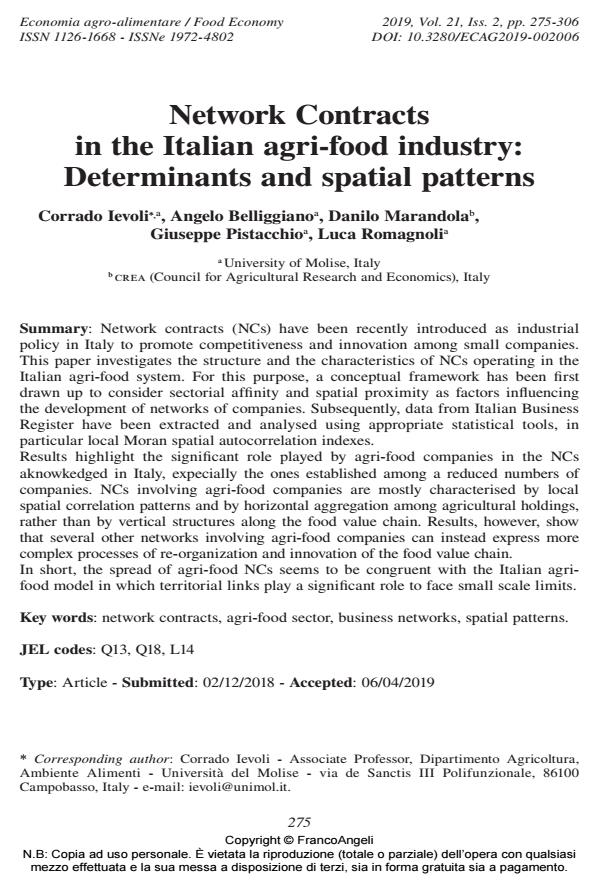Network Contracts in the Italian agri-food industry: Determinants and spatial patterns
Journal title ECONOMIA AGRO-ALIMENTARE
Author/s Corrado Ievoli, Angelo Belliggiano, Danilo Marandola, Giuseppe Pistacchio, Luca Romagnoli
Publishing Year 2019 Issue 2019/2
Language English Pages 32 P. 275-306 File size 237 KB
DOI 10.3280/ECAG2019-002006
DOI is like a bar code for intellectual property: to have more infomation
click here
Below, you can see the article first page
If you want to buy this article in PDF format, you can do it, following the instructions to buy download credits

FrancoAngeli is member of Publishers International Linking Association, Inc (PILA), a not-for-profit association which run the CrossRef service enabling links to and from online scholarly content.
Network contracts (NCs) have been recently introduced as industrial policy in Italy to promote competitiveness and innovation among small companies. This paper investigates the structure and the characteristics of NCs operating in the Italian agri-food system. For this purpose, a conceptual framework has been first drawn up to consider sectorial affinity and spatial proximity as factors influencing the development of networks of companies. Subsequently, data from Italian Business Register have been extracted and analysed using appropriate statistical tools, in particular local Moran spatial autocorrelation indexes. Results highlight the significant role played by agri-food companies in the NCs aknowkedged in Italy, expecially the ones established among a reduced numbers of companies. NCs involving agri-food companies are mostly characterised by local spatial correlation patterns and by horizontal aggregation among agricultural holdings, rather than by vertical structures along the food value chain. Results, however, show that several other networks involving agri-food companies can instead express more complex processes of re-organization and innovation of the food value chain. In short, the spread of agri-food NCs seems to be congruent with the Italian agrifood model in which territorial links play a significant role to face small scale limits.
Keywords: Network contracts, agri-food sector, business networks, spatial patterns.
Jel codes: Q13, Q18, L14
- Information and Communication Infrastructures and New Business Models in Rural Areas: The Case of Molise Region in Italy Corrado Ievoli, Angelo Belliggiano, Danilo Marandola, Pierluigi Milone, Flaminia Ventura, in European Countryside /2019 pp.475
DOI: 10.2478/euco-2019-0027 - Rural-Urban Linkages: Regional Financial Business Services’ Integration into Chilean Agri-Food Value Chains Eduardo Rodrigues Sanguinet, Francisco de Borja García-García, in Sustainability /2023 pp.10863
DOI: 10.3390/su151410863 - Neo-Endogenous Rural Development in Favor of Organic Farming: Two Case Studies from Italian Fragile Areas Angelo Belliggiano, Alberto Sturla, Marco Vassallo, Laura Viganò, in European Countryside /2020 pp.1
DOI: 10.2478/euco-2020-0001 - Supply chain networks in the Armenian agribusiness: Setting a benchmark Jon H. Hanf, Silva Atoyan, Linda Bitsch, Taras Gagalyuk, in ECONOMIA AGRO-ALIMENTARE 2/2019 pp.359
DOI: 10.3280/ECAG2019-002010 - The Impact of Instrumental Stakeholder Management on Blockchain Technology Adoption Behavior in Agri-Food Supply Chains Michael Paul Kramer, Linda Bitsch, Jon H. Hanf, in Journal of Risk and Financial Management /2021 pp.598
DOI: 10.3390/jrfm14120598 - Blockchain and Its Impacts on Agri-Food Supply Chain Network Management Michael Paul Kramer, Linda Bitsch, Jon Hanf, in Sustainability /2021 pp.2168
DOI: 10.3390/su13042168
Corrado Ievoli, Angelo Belliggiano, Danilo Marandola, Giuseppe Pistacchio, Luca Romagnoli, Network Contracts in the Italian agri-food industry: Determinants and spatial patterns in "ECONOMIA AGRO-ALIMENTARE" 2/2019, pp 275-306, DOI: 10.3280/ECAG2019-002006